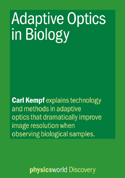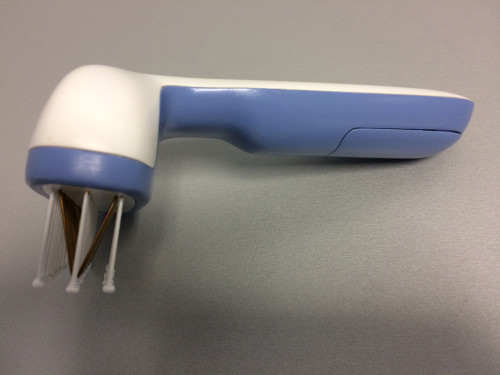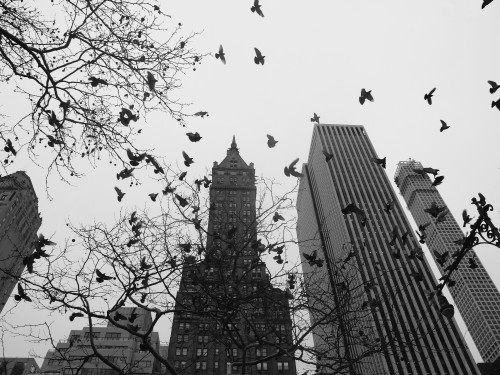Tag archives: biology
The February 2018 issue of Physics World magazine is now out
 By Matin Durrani
By Matin Durrani
You’ll be delighted to know that the February 2018 issue of Physics World is now out in print and digital format.
In our cover feature this month, science writer Jennifer Ouellette discovers how tiny midges can shed light on collective behaviour in physics. You can also discover from Helen Gleeson how physicists are seeking to create liquid-crystal contact lenses – and learn from Stephen Ornes more about the technological challenges of going to Mars.
Don’t miss either our interview with the physicist who heads Japan’s leading funding agency and find out from astrophysicist Elizabeth Tasker about her experiences as an overseas scientist in the country.
And our veteran North America correspondent Peter Gwynne assesses the impact that Donald Trump has had on US science, one year into his presidency.
Remember that if you’re a member of the Institute of Physics, you can read the whole of Physics World magazine every month via our digital apps for iOS, Android and Web browsers.
Let us know what you think about the issue on Twitter, Facebook or by e-mailing us at pwld@iop.org
View all posts by this author | View this author's profile
Adaptive optics in biology
By Matin Durrani
For centuries, astronomers looking up at the heavens through a telescope had a problem on their hands – the quality of their images depended on the strength and direction of the wind in the air. Trouble is, the Earth’s atmosphere isn’t uniform because its density – and thus its refractive index – varies from point to point as the wind blows. Result: distorted images.

Carl Kempf’s new short-form Physics World Discovery ebook is free to read
In 1953, however, astronomer Horace Babcock proposed a clever solution, which was to bounce incoming light off a device that can rapidly correct for changes in optical path-length, which flattens the wave-front and so counteracts the effects of aberration. Any remaining wave-front errors are measured after the correction, before a feedback control loop uses the measurement to continuously adjust the corrections applied to the wave-front.
That was the principle behind “adaptive-optics” technology, which has since gone on to become a routine and invaluable part of astronomy. Turns out, however, that the same principles can be used in microscopy too, leading to many applications of adaptive optics in medicine and biology too, as I’ve discovered by commissioning and editing a new short-form Physics World Discovery ebook by Carl Kempf.
Kempf is a senior systems engineer at the California-based firm Iris AO, Inc, which is heavily into adaptive-optics technology, having worked on sensing, actuation, and control systems for high-precision devices for more than 30 years. I’m pleased to say that Kempf’s short ebook, Adaptive Optics in Biology, is now available for you to read free in EPUB, Kindle and PDF format via this link.
To give you some more idea of what the book is about and his career to date, I put some questions to Kempf, which you can read below. Don’t forget either that there are plenty of other books in the Physics World Discovery series, ranging from multimessenger astronomy to quantitative finance.
View all posts by this author | View this author's profile
Creating human organs on chips
By James Dacey reporting from Boston, Massachusetts
Having left a rain-soaked Bristol on Monday, I was greeted by an even more rain-soaked Boston on Tuesday. Fortunately, I spent my first day in the US under a roof at the Wyss Institute for Biologically Inspired Engineering. I was there to learn about an intriguing technology that reproduces the functionality of human organs on polymer chips about the size of a little finger.
View all posts by this author | View this author's profile
Physics graduate is just 14, high drama at the LHC, the physics of number two
By Hamish Johnston and Michael Banks
Carson Huey-You was just 11 years old when he arrived at Texas Christian University to study physics. Now, at the ripe old age of 14, he is about to graduate, according to an article in the Huffington Post. “I knew I wanted to do physics when I was in high school, but then quantum physics was the one that stood out to me, because it was abstract,” says Huey-You. Most American children start high school at age 14, but Huey-You was learning calculus by the time he was three – a subject usually reserved for high school seniors. And precociousness runs in the family because his younger brother Cannan is starting university in September aged 11. The siblings are delightful and interviewed in the above video.
View all posts by this author | View this author's profile
Live space station upgrade, more zombie physics, T-shirts for LIGO

Working in space: A still image from the NASA spacewalk video. (Courtesy: NASA)
By Hamish Johnston
NASA is live streaming a video of a spacewalk on its Facebook page, and you just might be able to catch it live from the International Space Station – or watch it again. The video shows astronauts Shane Kimbrough and Peggy Whitson upgrading the space station’s power system – and it looks like hard work to me.
View all posts by this author | View this author's profile
Scientists officially ground Spider-Man

Stick together: both ants and geckos have adhesive pads that let them scale vertical surfaces. (Courtesy: A Hackmann/D Labonte)
By Tushna Commissariat
Don’t tell the kids just yet, but becoming Spider-Man, even after being bitten by a radioactive spider, is looking less and less likely for us humans – we are just too big. The latest work, done by researchers at the University of Cambridge in the UK, has shown that gecko-sized is pretty much the largest you can be if you realistically want to scale up walls with adhesive pads. Any bigger, and most of your surface area would need to be covered in large sticky pads to pull off the gravity-defying walk. Indeed, the team estimates that roughly 40% of an average human being’s total body surface would need to be sticky – this means a whopping 80% of your front would be covered in adhesive pads.
Zapping head lice and a job that is out of this world

Nit picker: the cold plasma lice killer. (Courtesy: Fraunhofer IST)
By Hamish Johnston
Do your children have head lice again? Now you don’t have to comb their hair until your arm goes numb or cover their head with goop. Instead, you can zap them away using a plasma. I’m not suggesting that you put your child’s head into ionized gas that’s hotter than the Sun – it turns out that a “cold atmospheric pressure plasma” will do the trick.
That’s the claim of researchers at the Fraunhofer Institute for Surface Engineering and Thin Films in Göttingen, Germany. The team has created the above prototype, which creates a plasma using a high-voltage generator that sends short pulses to the teeth of the comb. The pulses ionize air molecules surrounding the teeth, but they are so short that the resulting plasma does not heat up. The charged ions and electrons in the plasma make short work of killing lice and their eggs, but are harmless to humans – at least according to Wolfgang Viöl and colleagues, who will be unveiling their device later this month at the MEDICA trade fair in Düsseldorf.
View all posts by this author | View this author's profile
New York dims its lights for birds

Birds flock over Central Park. (Courtesy: iStockphoto/giovanni1232)
By James Dacey
It’s been a great week for birds – or at least those flying over the state of New York – after state governor Andrew Cuomo pledged to create safer migration routes for our feathered friends. All state buildings will now have to comply with a national US initiative that seeks to curb levels of light pollution, which can disorient birds and lead to huge numbers of avian deaths by “fatal light attraction”.
Many species of bird rely on the light from star constellations to help them navigate during spring and autumn migrations. Unfortunately, artificial light sources can throw the animals off course, and light reflected from glass can cause the birds to smack into windows, walls, floodlights and other hard surfaces. It is estimated that as many as a billion birds succumb to this cruel end each year in the US alone, according to the US Department of Agriculture.
View all posts by this author | View this author's profile
